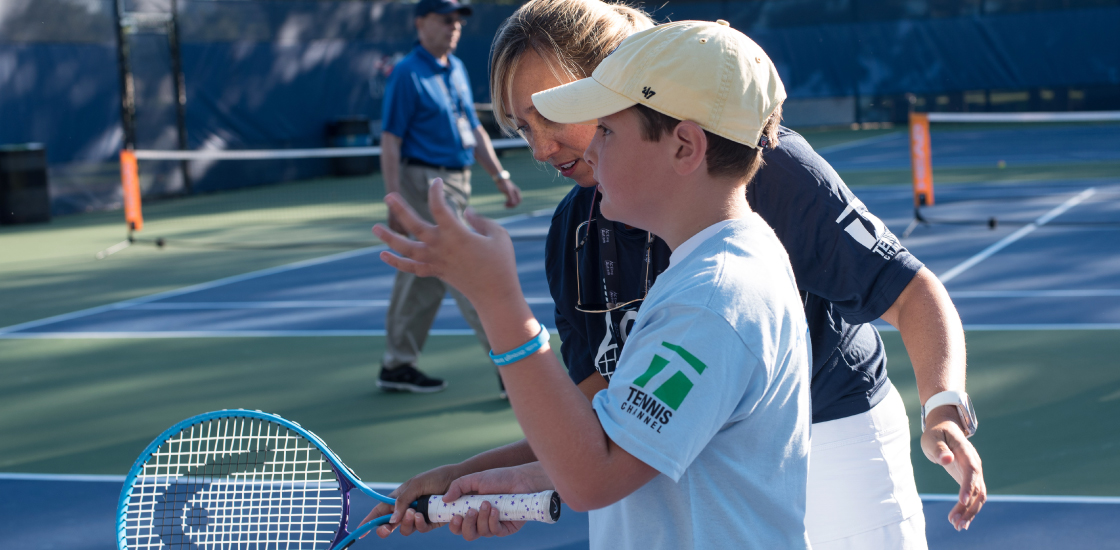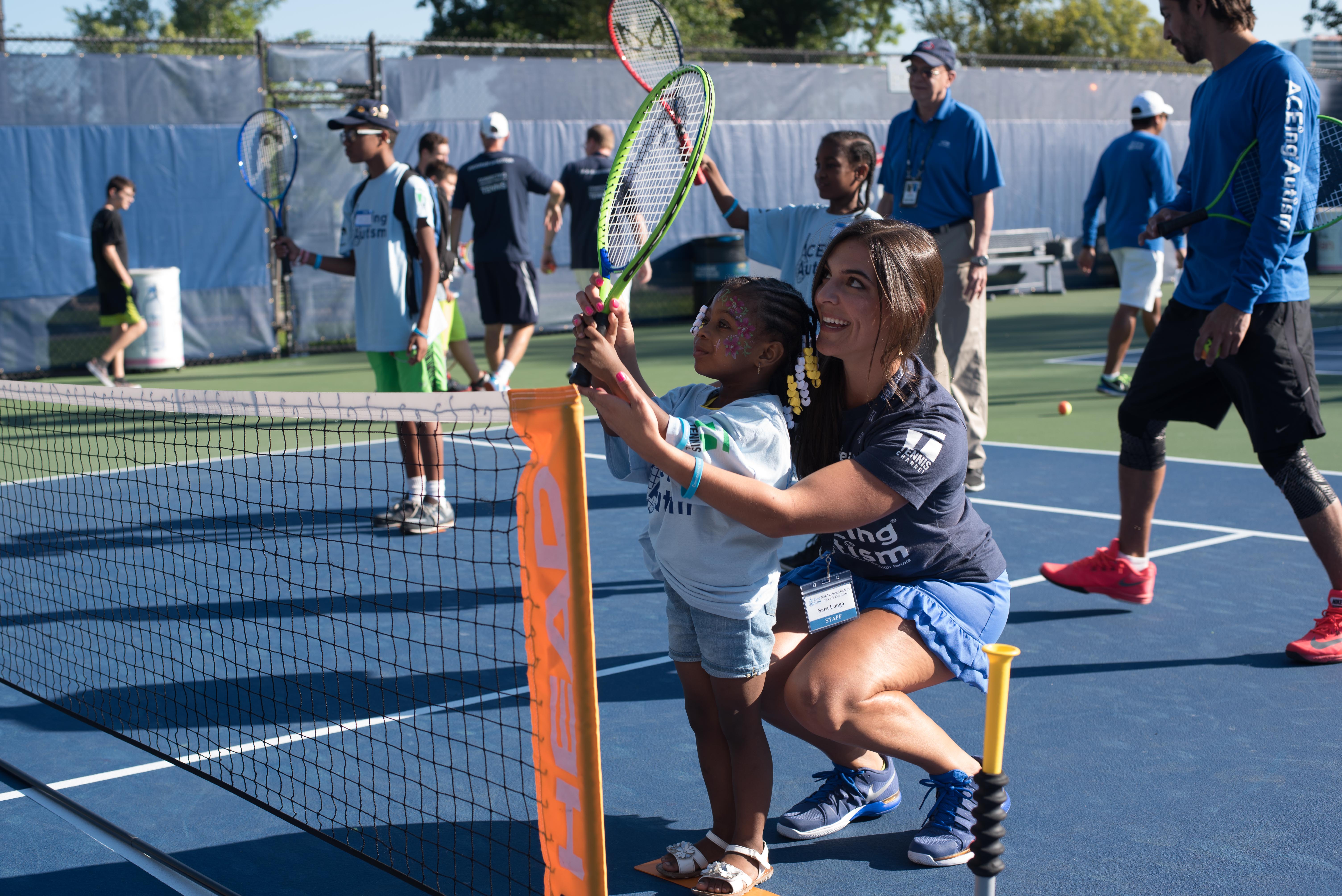Tennis program serves up benefits for children with autism
Tennis is a social game, requiring players to predict and respond to their opponent’s behavior. That may help some children with autism.

I vividly remember the day back in 2008 that Zoe, a 4-year-old girl with autism, came to visit me in my child neurology clinic at Boston Children’s Hospital. Zoe was minimally verbal and beginning to show challenging behaviors, such as impulsively bolting out of her classroom and excessively mouthing objects.
I had no idea then that Zoe would be the first pupil in an innovative tennis program that my husband and I designed, or how much that program would benefit her.
Zoe was an extremely active, athletic child, happiest when she could run, play and engage in physical activity. Her mother, Mira, lamented the fact that Zoe lacked an adequate physical outlet. They had tried a few sports programs designed for children with developmental disabilities, but none of them were designed to maximize Zoe’s athletic potential.
I mentioned Mira’s concerns to my husband, Richard, a former college tennis player and entrepreneur. I told him that many parents of children with autism had expressed similar frustrations to me about their inability to find recreational sports programs suitable for their children.
Richard and I started to imagine a tennis program for children with autism. In addition to giving children a physical outlet, tennis involves a good degree of reciprocity. A rally between opponents embodies a physical dialogue, with success often defined by players’ ability to read and predict the behavior of their opponent.
We envisioned a program that addressed not only tennis skills, but also some social skills, such as eye contact and cooperative play. We also thought we could adapt the training to each child’s specific developmental needs, with a child assigned to his or her own instructor, and modules that progressed from basic motor skills to more advanced tennis skills.
A few days later, I ran the idea past Mira, who was also a competitive tennis player. She immediately volunteered to include Zoe in a pilot program. We recruited two of Zoe’s classmates, ages 5 and 6, to join Richard on a tennis court the following weekend.
We never expected that this initial outing would grow into a national organization called ACEing Autism, serving more than 1,000 children across more than 20 states.
Net gain:
It has taken eight years to get there. When Richard joined Zoe and her classmates on that outdoor clay tennis court in a suburb of Boston, he had never met a child with autism.
He began the lesson as he would with any young child, reviewing her grip on the racket and showing her how to swing. And then he began to feed the children foam balls to hit. But within minutes, Zoe had taken a bite out of a ball. Another child was engrossed in the texture of the clay, happily digging a small hole on the court surface. The third child had fled the court and was jumping in a puddle.
Richard and I were undeterred, determined to adapt to the needs of these children. So before the next scheduled session a week later, Richard set up meetings with autism intervention experts and parents of children with autism. He wanted advice on how to engage the children and improve their focus.
Based on this advice, Richard moved the lessons off the clay court to a smaller blacktop surface with a smaller net, as a way of limiting the sensory stimulation. He also added visual cues, such as colored circles on the court, to show the child where to stand, and he gave precise instructions, such as, “Pick up 10 balls,” rather than saying, “Time to pick up balls,” to provide the children with more structure.
The next week went much more smoothly. But it was just the beginning of our quest to develop an outstanding program that would be accessible to children spanning the autism spectrum.
Sense of community:
Over the next year, we worked closely with clinicians, physical therapists, intervention experts and parents, including Mira, to refine the program. We built a board of directors that included experts in both tennis and autism. We developed a curriculum of weekly one-hour lessons, grouped into 8- to 10-week sessions, that would recur throughout the year.
The children receive a visual schedule before each lesson that provides pictures of each activity that the child will perform during the hour. The schedule gives the children a sense of structure and alleviates anxiety about the unknown.
We split each lesson into 10-minute modules. The first focuses on basic gross motor activities such as running, jumping and tossing balls on the court. The activities then become more tennis-specific over the hour, ending with each child hitting balls over the net. Each module is tailored to the child’s developmental level. Some children with low muscle tone require considerable assistance in simply holding a racket, but more athletic children such as Zoe might be ready to rally by the end of eight weeks.
Throughout the lesson, we also promote social interaction. During the warm-up, the children stand shoulder to shoulder on the baseline and pass a tennis ball down the line. The child passing the ball says the recipient’s name, promoting a simple social connection. And each lesson ends with a group cheer — “1-2-3, we love tennis!” — fostering a sense of community among the children and volunteers. As a result, each child not only gains proficiency in tennis, but also in attention, engagement and social interaction.

After two years, the program expanded to two sites in Boston, servicing 30 children with a wide array of challenges, such as severe language difficulties, repetitive behaviors, aggressive outbursts, anxiety and profound sensory aversions. Many of these children had ‘failed’ out of sports programs that did not provide the necessary support. Rather than turn any child away, we adapted the program to suit the child’s needs.
Team sport:
These early successes inspired us to launch the program nationally. When I joined the faculty of the University of California, Los Angeles in 2010, Richard decided to make the program his full-time job. ACEing Autism is now host to 45 tennis programs for children with autism across the country — an expansion made possible by the development of a detailed manual and standardized teacher trainings. We plan to have 50 sites across the United States by the end of this year. I serve on the board of directors and help facilitate connections to the broader autism community.
The program is appropriate for children ages 4 to 18 who fall within a range of developmental levels and demographics. More than half of the children who start the program have never participated in an organized sport, and three-quarters have never been exposed to tennis.
About 1,200 volunteers have donated more than 37,000 hours to coach the children. Many of our volunteers had never met a child with autism but have since been inspired to pursue careers dedicated to helping children with autism, such as speech therapy, clinical psychology or medicine. It has been incredibly rewarding to mentor some of these volunteers.
The program has also raised autism awareness throughout the national tennis community. We hold annual events at the U.S. Open, and the Tennis Channel featured the program several times in the past three years in one- to two-minute recurring segments called “Court Report.”
Keeping score:
As a researcher searching for brain-based biomarkers of autism, I’m always looking for ways to quantify the benefits of a therapy. Through pilot studies involving 20 children at two Los Angeles sites, we are measuring changes in the children’s fine and gross motor skills, eye contact, behavior regulation and attention. The children will soon come to my lab for a standard battery of psychological and motor assessments before and after their session.
Ultimately, we hope to use electrophysiological measures to track changes in the brain. There is some early evidence that behavioral intervention can change neural circuitry in children with autism, but no one has investigated whether these changes accompany participation in sports programs1,2. We hypothesize that ACEing Autism can rewire the brain in a way that fosters better motor skills and helps alleviate the core features of autism.
One child began the program with repetitive behaviors so intrusive that he struggled to hold a racket. After eight weeks, he was standing at the net and successfully hitting balls a coach fed to him, erupting in laughter after each shot. Truthfully, I rarely see such direct and immediate benefit from the many treatments that I prescribe for the children with autism in my clinic.
A more meaningful indicator of the program’s success may be the fact that children stay in it for years — because it’s fun and provides a place for families affected by autism to connect.
Zoe, now 13, still participates. Her forehand and backhand are better than those of most typical children. Her social skills have improved, too. “Nearly all the skills that a multitude of teachers and therapists spend the week isolating and working on with my daughter can be practiced and applied in one tennis clinic,” Mira recently told me. “She has gone from a kid who couldn’t focus and bolted all over the place to a kid who loves coming to tennis, follows the flow of the clinic like a champ and has a killer forehand volley!”
As a physician-scientist, I am dedicated to caring for children with autism and making discoveries that improve their lives. This experience has reminded me of the impact that we can make by being of service outside the clinic and lab, by creating connections with families that, arguably, have the greatest expertise in the needs of children with autism. When I started out on this path with Richard, I never predicted that one of my most rewarding professional experiences would take place on a tennis court.
Shafali Jeste is associate professor of psychiatry and neurology at the University of California, Los Angeles and a lead investigator at the university’s Center for Autism Research and Treatment.
References:
Recommended reading

Expediting clinical trials for profound autism: Q&A with Matthew State

Too much or too little brain synchrony may underlie autism subtypes
Explore more from The Transmitter

Mitochondrial ‘landscape’ shifts across human brain

